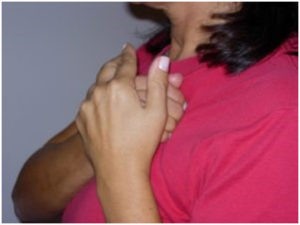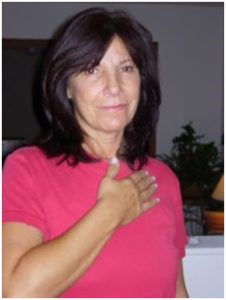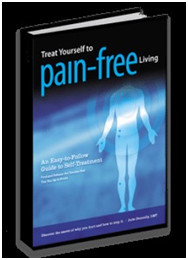Frozen Shoulder, Rotator Cuff Pain, No More!
Author: Julie Donnelly, LMT –The Pain Relief Expert
Editor: Dr. Steve Chaney
 A frozen shoulder is a mild sounding name for a seriously painful condition that prevents your shoulder and arm from moving. Muscles in your entire shoulder are responsible for frozen shoulder and rotator cuff injuries. Each one needs to be treated for relief, and each impacts the others so it’s important to treat all of them to achieve frozen shoulder pain relief.
A frozen shoulder is a mild sounding name for a seriously painful condition that prevents your shoulder and arm from moving. Muscles in your entire shoulder are responsible for frozen shoulder and rotator cuff injuries. Each one needs to be treated for relief, and each impacts the others so it’s important to treat all of them to achieve frozen shoulder pain relief.
Last month I showed you how to do the treatment for the Infraspinatus muscle in the back of your shoulder. This month we’ll talk about two muscles in your chest that prevent your arm from going back.
Muscles that Cause Frozen Shoulder and Rotator Cuff Injuries
The muscles are your Pectoralis Minor and Pectoralis Major which are on the front of your shoulder. If you put your hand on your chest as shown, you are right on top of both muscles. You can also move your hand down a bit to treat the rest of the two muscles.
 The deeper muscle is your Pectoralis Minor which goes from your ribs up to the top of your shoulder. This muscle pulls your shoulder forward and causes your back to round. When it is in spasm, you have poor posture and can’t bring your shoulder back.
The deeper muscle is your Pectoralis Minor which goes from your ribs up to the top of your shoulder. This muscle pulls your shoulder forward and causes your back to round. When it is in spasm, you have poor posture and can’t bring your shoulder back.
The surface muscle is your Pectoralis Major which goes from your chest bone (sternum) to your upper arm. When this muscle contracts normally, you bring your arm in toward your trunk and/or across the front of your body. If it is in spasm, you can’t bring your arm out away from your body.
You can see how these two muscles will cause frozen shoulder by holding your arm tight to your body.
Since they both move your shoulder and arm, while they aren’t technically rotator cuff muscles, they impact your rotator cuff. So, these muscles have to be addressed as well for frozen shoulder pain relief.
Frozen Shoulder Pain Relief Treatment and Rotator Cuff Injury Treatment
Place your opposite hand onto your chest as shown. For example, if you are treating your left shoulder, you will put your right hand on the bottom. Press your fingertips into your chest and place your left hand on top of your right hand. Press into the muscles with both hands to add strength to the movement.
 If you don’t feel the tender point at first, just move your fingertips around and keep pressing. When you hit a sore point, you are on top of the spasm. Hold the pressure for 30 seconds and repeat. Do this 2-3 times, and then look for another tender point.
If you don’t feel the tender point at first, just move your fingertips around and keep pressing. When you hit a sore point, you are on top of the spasm. Hold the pressure for 30 seconds and repeat. Do this 2-3 times, and then look for another tender point.
It is most beneficial if you combine this treatment with the treatment for the Infraspinatus that was shown previously.
There are so many shoulder treatments involved in the release of frozen shoulder and rotator cuff injuries that I can’t show all of them. If you suffer from shoulder pain or limited flexibility, I suggest you look at my book Treat Yourself to Pain-Free Living. This book will help you with frozen shoulder pain relief.
Wishing you well,
Julie Donnelly
About The Author
Julie Donnelly is a Deep Muscle Massage Therapist with 20 years of experience specializing in the treatment of chronic joint pain and sports injuries. She has worked extensively with elite athletes and patients who have been unsuccessful at finding relief through the more conventional therapies.
 She has been widely published, both on – and off – line, in magazines, newsletters, and newspapers around the country. She is also often chosen to speak at national conventions, medical schools, and health facilities nationwide.
She has been widely published, both on – and off – line, in magazines, newsletters, and newspapers around the country. She is also often chosen to speak at national conventions, medical schools, and health facilities nationwide.
These statements have not been evaluated by the Food and Drug Administration. This information is not intended to diagnose, treat, cure or prevent any disease.
